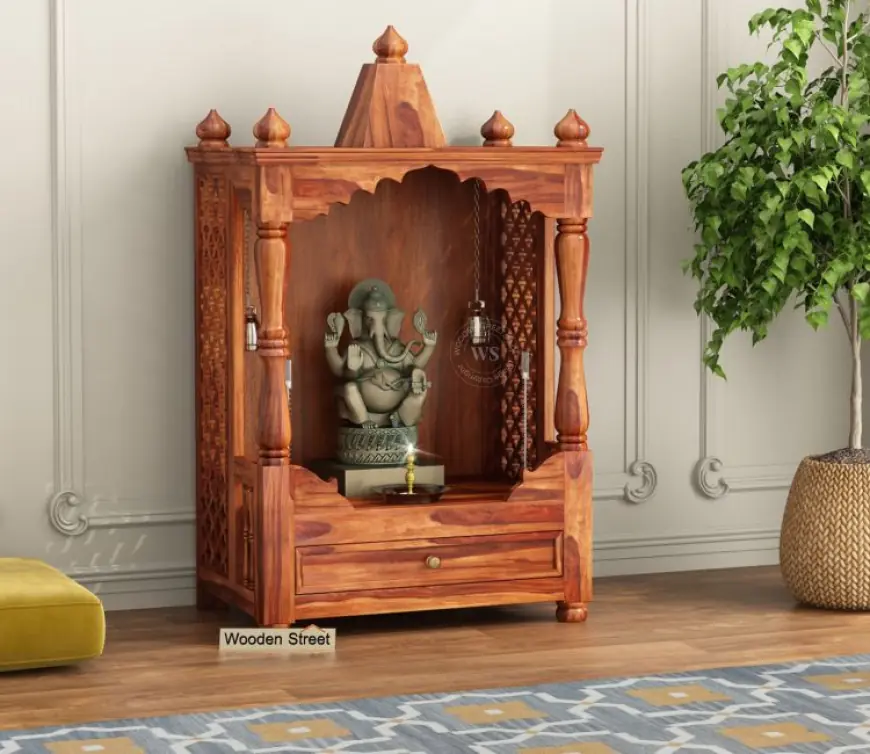Mandir for Home Vastu Ideas to Enhance Spiritual Vibes

In Indian households, a mandir for home is not just a place of worship but also a spiritual corner that brings peace and positivity. According to Vastu Shastra, the ancient Indian science of architecture, the correct placement and design of the mandir can significantly influence the overall energy of your home. By aligning your home temple with Vastu principles, you can invite prosperity, clarity of mind, and spiritual well-being.
Importance of Vastu in Mandir Placement
The placement of the mandir for home plays a vital role in maintaining a flow of positive energy. Vastu recommends that the northeast direction, known as the Ishan corner, is the most auspicious for setting up a home temple. This direction is believed to attract divine energy and helps in creating a tranquil environment conducive to prayers and meditation. If placing the mandir in the northeast is not possible, alternatives like the east or north direction are also acceptable. It is advisable to avoid placing the mandir in the bedroom or near bathrooms, as these areas are not considered spiritually pure.
Design and Layout Tips According to Vastu
The structure and layout of the mandir for home should be designed with simplicity and serenity in mind. A wooden mandir with a dome or pyramid-like top is considered beneficial in Vastu. The platform where idols are placed should not be too high or too low. Ideally, the idols should be placed at chest level when seated for prayer. According to Vastu, the idols should not face each other or the door directly. There should also be some space between the wall and the idol to allow for proper circulation of air and energy.
Lighting is another crucial factor. A well-lit mandir, especially with natural light from the east, helps in enhancing the spiritual atmosphere. Diyas or lamps should be lit in the southeast direction within the temple. Using soft yellow or warm white lighting creates a peaceful and divine ambiance.
Ideal Materials and Colours for Positive Energy
The materials used for the mandir for home must be natural and harmonious with the environment. Wood is the most Vastu-compliant material, as it represents warmth, grounding, and spiritual connection. Marble and stone can also be used, particularly in larger houses. Avoid using glass or metal for constructing the entire temple, as these materials are considered too sharp and cold in energy.
As for colours, light tones are always preferable. Shades of white, off-white, light yellow, or soft pink help in creating a calm and welcoming aura. These colours are believed to attract divine energy and enhance mental peace. Avoid dark shades like black, grey, or deep red in the pooja room, as they may absorb rather than reflect energy.
Ritual Cleanliness and Sacred Space Maintenance
Vastu also places a strong emphasis on cleanliness, both physical and spiritual. The mandir for home should be kept clutter-free and clean at all times. Daily cleaning, changing the water in the offering vessel, and ensuring fresh flowers are placed regularly can help maintain a sacred environment. Incense sticks and camphor can be used to purify the air and increase the flow of positive vibrations. The area should also be free from unnecessary storage or household items that do not belong in a place of worship.
Apart from physical cleanliness, it’s also essential to maintain a peaceful and meditative mindset while entering or sitting in the mandir. Reciting prayers, chanting mantras, or simply spending a few quiet moments here can help recharge emotional and spiritual energy.
Things to Avoid in Mandir Setup
While it’s important to know what to do, it’s equally important to know what to avoid. A mandir for home should never be placed directly under a staircase or in the basement, as these are locations with limited positive energy. Also, avoid placing the mandir against a wall that is shared with a bathroom or a toilet, as this can disrupt the sanctity of the space. Storing unused items, broken idols, or expired prayer materials in the mandir area is also discouraged in Vastu, as it may block the energy flow and lead to stagnation.
Electronic items like televisions, sound systems, or loudspeakers should not be placed near or inside the mandir. The temple should remain a space of silence, reflection, and serenity, free from the distractions of daily life.
Creating a Personal Connection with the Mandir
Ultimately, a mandir for home is a highly personal space, and Vastu serves as a guide to enhance its energy. Beyond placement and materials, what truly matters is the devotion and intention with which the space is used. Decorating the mandir with symbols that resonate with your beliefs, using fragrances that calm your senses, and maintaining a regular spiritual routine can all contribute to strengthening the connection between you and your home temple.
Even a small mandir, when placed and maintained according to Vastu principles, can become a powerful energy centre in your home. It creates an aura of positivity, helps reduce stress, and reinforces a daily rhythm of mindfulness and gratitude. Incorporating Vastu ideas into your mandir setup is not about rigid rules, but about creating a peaceful spiritual retreat that nurtures your inner self.
By combining Vastu wisdom with personal faith, your mandir for home becomes more than just a sacred space—it becomes a source of harmony, strength, and divine inspiration for everyone in the household.
What's Your Reaction?
 Like
0
Like
0
 Dislike
0
Dislike
0
 Love
0
Love
0
 Funny
0
Funny
0
 Angry
0
Angry
0
 Sad
0
Sad
0
 Wow
0
Wow
0


















































